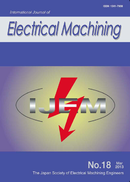27 巻
選択された号の論文の6件中1~6を表示しています
- |<
- <
- 1
- >
- >|
Review
-
原稿種別: Review
2022 年27 巻 p. 1-
発行日: 2022年
公開日: 2022/12/14
PDF形式でダウンロード (1795K)
Paper
-
原稿種別: Paper
2022 年27 巻 p. 8-
発行日: 2022年
公開日: 2022/12/14
PDF形式でダウンロード (1394K) -
原稿種別: Paper
2022 年27 巻 p. 16-
発行日: 2022年
公開日: 2022/12/14
PDF形式でダウンロード (1775K) -
原稿種別: Paper
2022 年27 巻 p. 22-
発行日: 2022年
公開日: 2022/12/14
PDF形式でダウンロード (2270K) -
原稿種別: Paper
2022 年27 巻 p. 28-
発行日: 2022年
公開日: 2022/12/14
PDF形式でダウンロード (1036K) -
原稿種別: Paper
2022 年27 巻 p. 35-
発行日: 2022年
公開日: 2022/12/14
PDF形式でダウンロード (1167K)
- |<
- <
- 1
- >
- >|
